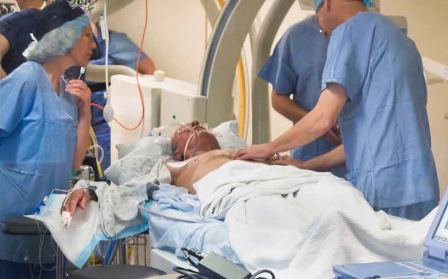St Andrew’s War Memorial Hospital is among the first in Australia to implant the S-ICD™ implantable defibrillator system for patients at risk of sudden cardiac arrest.
Cardiologists at St Andrew’s implanted the world’s first and only implantable heart defibrillator system in 2014. The system is placed under the skin, without any direct contact to the heart.

St Andrew’s cardiologist and Queensland Cardiovascular Group Director, Dr John
Hayes explains this new evolution in defibrillation therapy provides protection for patients who are at risk of sudden cardiac arrest yet is less invasive and carries less risk.
“This new heart defibrillator is designed to provide the same defibrillation protection
as a traditional transvenous implantable cardioverter defibrillators (ICDs), however,
the advantage of the S-ICD™ System is it sits entirely just below the skin and uses
a lead wire implanted along the bottom of the rib cage and breastbone. The lead is
placed under the skin rather than through a vein into the heart, leaving the heart and
blood vessels untouched and providing a new and exciting solution for both physicians and patients that is less invasive with less risk,” Dr Hayes said.
Patients can be at risk of sudden cardiac arrest as a result of genetic conditions or previous cardiac disease, and recent estimates show about 80,000 people in the Australia are at risk of sudden cardiac arrest (SCA).
“Sudden cardiac arrest can occur with very little warning and may result in death
if not treated quickly. It is an abrupt loss of heart function and is caused by rapid
and/or chaotic electrical activity of the heart known as ventricular tachycardia or
ventricular fibrillation,” Dr Hayes said.
The S-ICD system consists of two components: a pulse generator and an electrode. The pulse generator is a small battery-powered device that constantly monitors a person’s heart rhythm and can provide a small electrical shock to restore the heart to normal rhythm when the heart is beating dangerously fast (tachycardia) or chaotically.
The electrode enables the device to sense the cardiac rhythm and serves as a pathway for electric shock delivery when needed. The S-ICD system is suitable for a large population of patients at risk of SCA, however it is not intended for patients who have symptomatic bradycardia (a slow heart beat) and who require a pacemaker.
The S-ICD™ System is commercially available in many countries in Europe as well as New Zealand and the U.S. The Australian TGA granted regulatory approval for the S-ICD™ System in 2014. To date, more than 8,000 devices have been implanted in patients around the world.